
6288
.pdf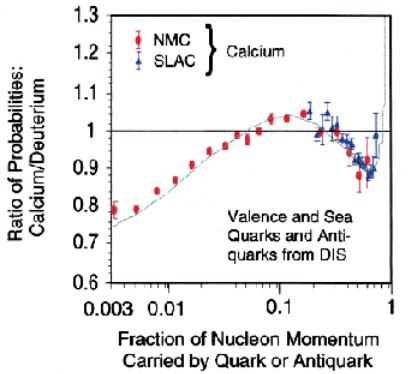
Nuclear Physics: The Core of Matter, The Fuel of Stars
http://www.nap.edu/catalog/6288.html
44 |
NUCLEAR PHYSICS: THE CORE OF MATTER, THE FUEL OF STARS |
FIGURE 2.8 Results of deep-inelastic-scattering experiments carried out at CERN and SLAC that probe the distribution of quarks and antiquarks in nuclei. The results are plotted as the ratio of the probabilities for finding quarks and antiquarks with a given fraction of the average nucleon’s momentum in a medium-mass nucleus versus deuterium. The sizable deviations of this ratio from unity demonstrate that the quark environment inside nuclear matter is different from that inside a free nucleon. Important nuclear effects are observed at both small momentum fractions, where induced sea quarks are expected to dominate, and at larger values, in the realm populated primarily by valence quarks. Such measurements provide one window on possible changes in hadron substructure inside nuclear matter. For example, in the green model calculation that reproduces the data, it is assumed that bound neutrons and protons have systematically different sizes than their free counterparts.
share of the nuclear momentum, which will first be measured in proton-nucleus collisions at RHIC.
Even more dramatic changes in structure, offering unique opportunities to test QCD, can occur for very fast hadrons passing through nuclear matter. During their short traversal time, quantum mechanics allows these particles to exist not just as any one of the known free hadrons, but as some combination of many of
Copyright © National Academy of Sciences. All rights reserved.
Nuclear Physics: The Core of Matter, The Fuel of Stars
http://www.nap.edu/catalog/6288.html
THE STRUCTURE OF THE NUCLEAR BUILDING BLOCKS |
45 |
them (e.g., a combination of a proton and its various excited states, which may have a much smaller size than a free proton). Experimental searches for effects of such shrunken, transitory hadrons are of special interest, because QCD predicts that they will survive passage through nuclear matter much more readily than hadrons of ordinary size. Their survival is enhanced, according to QCD, because the various color charges are closer together inside a small hadron, and interactions with surrounding nucleons grow weaker with decreasing separation of these internal colors. This QCD prediction—that a nucleus will act as a sort of hadron “strainer”—will be tested in the coming decade by experiments that attempt to produce such shrunken hadrons in hard, high-energy collisions of electron, proton, or heavy-ion beams with nucleons in nuclei. If the prediction is confirmed, then nuclei may be used as filters to study the transition from the simplest QCD interactions to the complicated ones that dominate in the more permanent world of nucleons and nuclei. Full exploitation of such filtering possibilities is likely to require a new accelerator, capable of delivering continuous electron beams, of substantially higher energy than are available at CEBAF, or colliding beams of electrons and protons.
It is equally important to study how the interactions of lower-energy hadrons change when they are embedded in nuclear matter. The effects of the nuclear medium on nucleon-nucleon and pion-nucleon forces have been investigated intensively for many years. There is now renewed interest in the interactions of hadrons containing a strange valence quark, because they may play an important role in the high-density matter present in neutron stars, as detailed in Chapter 5. The lightest mesons that contain a strange valence quark or antiquark are called kaons. Kaons can be produced in the laboratory—and collected to form a beam— or can be implanted in nuclei by nuclear reactions that substitute a strange quark for an up or down quark. Experiments at CEBAF and other laboratories will provide information on the interaction of implanted, negatively charged kaons with the surrounding nucleons in a nucleus. It has been predicted that the partial restoration of chiral symmetry in nuclear matter, discussed above, will change this interaction at very low energy from being slightly repulsive in the free case to attractive in nuclei. If this prediction is borne out by future experiments, it could have a strong bearing on the possibility that large numbers of kaons “condense” into a single quantum state in neutron stars.
OUTLOOK
Nucleons are built from quarks and gluons. Yet nearly all of their mass— hence, the total mass of which we and our surroundings are made—appears to arise not from intrinsic quark and gluon masses, but rather from the excess baggage the quarks carry by virtue of their confinement within the nucleon. It is crucial for understanding the structure of matter to test the validity of QCD as a
Copyright © National Academy of Sciences. All rights reserved.
Nuclear Physics: The Core of Matter, The Fuel of Stars
http://www.nap.edu/catalog/6288.html
46 |
NUCLEAR PHYSICS: THE CORE OF MATTER, THE FUEL OF STARS |
theory of quark confinement within hadrons. The next decade should bring enormous progress toward a meaningful confrontation of theory and experiment.
The new facilities at CEBAF and RHIC, together with continuing opportunities for selected experiments at high-energy laboratories, will dramatically improve empirical knowledge of nucleon structure. Ongoing investigations of the meson spectrum should confirm or disprove the discovery of hadrons whose primary constituents are gluons, thereby testing a prediction directly tied to the confinement mechanism of QCD. Measurements of pion interaction probabilities at low energies will reveal whether QCD leads to a self-consistent treatment of the observed violations of one of the theory’s basic symmetries. This experimental progress will exploit a wide variety of accelerator facilities and state-of- the-art instrumentation. Still, the quest for ultimate understanding of the excess baggage carried by quarks within nucleons is likely to require upgrades to currently available facilities. For example, continuous electron beams of higher energy or a spin-polarized, electron-proton collider may be needed to probe correlated behavior among pairs of quarks, or spin contributions from the abundant gluons, which each carry less than a few percent of the nucleon’s momentum.
In parallel with experimental progress, advances in computer performance and in theoretical techniques will fuel more quantitatively credible numerical solutions of QCD on a space-time lattice. Direct comparisons of experimental results to quantitative QCD predictions for aspects of meson and nucleon structure will have to form one of the primary testing grounds for the theory, just as the validity of quantum electrodynamics has been established in good part by quantitative accounts for observed details of atomic energy levels. On the other hand, it is unlikely that numerical solutions of QCD will be viable within a decade for systems containing more than a single nucleon. Further development of more phenomenological approaches, inspired by QCD but also guided by experimental results, will be needed to establish more firmly the QCD basis for the force between nucleons, or the structure of hadrons in dense nuclear matter.
Investigations of the evolution of hadron structure with the density and temperature of surrounding nuclear matter are just beginning. Resolution of some of the relevant issues, such as QCD effects on the passage of fast hadrons through nuclear matter, may well require accelerator facilities with beam energies and characteristics beyond those now available. Other questions, such as the occurrence of pion or kaon condensation or of a transition from nuclear to quark matter at very high densities, may only be settled by combining substantial extrapolations from laboratory experiments with successful models of stellar behavior, constrained by astronomical observations. In addressing these issues, nuclear physicists are attempting to build an essential bridge, linking the fundamental theory of nature’s strongest force to the makeup of the densest objects in the cosmos, and spanning the microscopic structure of the atomic nuclei that constitute nearly all of the mass we observe around us.
Copyright © National Academy of Sciences. All rights reserved.
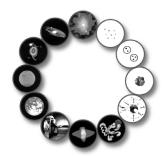
Nuclear Physics: The Core of Matter, The Fuel of Stars
http://www.nap.edu/catalog/6288.html
THE STRUCTURE OF NUCLEI |
47 |
3
The Structure of Nuclei
INTRODUCTION
The nucleus, the core and center of the atom, is a quantal many-body system governed by the strong interaction. Just as hadrons are composed of quarks and gluons, the nucleus is composed of the most stable of these hadrons—neutrons and protons. The question of how the strong force binds these nucleons together in nuclei is fundamental to the very existence of the universe. A few minutes after the Big Bang, the mutual interactions between nucleons led to the formation of light nuclei. These, and the subsequent nuclear process synthesizing heavier nuclei during stellar evolution and in violent events like supernovae, have been crucial in shaping the world we live in.
One of the central goals of nuclear physics is to come to a basic understanding of the structure and dynamics of nuclei. In approaching this goal, nuclear physicists address a broad range of questions, from the origin of the complex nuclear force to the origin of the elements. Among the key issues still to be resolved are the following:
•How do the interactions between quarks and gluons generate the forces responsible for nuclear binding?
•What is the microscopic structure of nuclei at length scales of the size of the nucleon? Is this structure best understood by including quarks and gluons explicitly in the treatment of nuclei?
•How are the different approximate symmetries that are apparent in nuclear structure related to the underlying interaction and how can they be derived from many-body theory?
47
Copyright © National Academy of Sciences. All rights reserved.
Nuclear Physics: The Core of Matter, The Fuel of Stars
http://www.nap.edu/catalog/6288.html
48 |
NUCLEAR PHYSICS: THE CORE OF MATTER, THE FUEL OF STARS |
•What are the limiting conditions under which nuclei can remain bound, and what new structure features emerge near these limits?
•What is the origin of the naturally occurring elements of our world?
Quantitative answers to these questions are essential to our understanding of nuclei; they also have a potential impact far beyond nuclear structure physics. Probes of short-range structures in nuclei can illuminate the nature of quark confinement, by exposing the extent to which quarks either remain confined to their particular neutrons or protons within nuclear matter or are shared among nucleons as electrons are shared in molecules. As yet poorly understood properties of medium-mass nuclei and of very neutron-rich nuclei critically affect the collapse and explosion of supernovae. In creating the heaviest nuclei in the laboratory, nuclear physicists are extending the periodic table of the elements and revealing deviations from chemical periodicity. Among the new isotopes they have produced in approaching the limits of nuclear stability are ones whose radioactive decay will provide crucial new tests of fundamental symmetry principles.
Progress in all these areas relies on technical advances in theoretical and computational approaches, as well as in accelerator and detector design. For example, investigations of short-range structures in nuclei have been spurred by novel developments in proton accelerators and, especially, by the advent of continuous high-energy electron beams. The role of quarks and gluons in such structures is most likely to be revealed in the lightest nuclei, for which experimental maps can now be compared to essentially exact theoretical calculations based on the picture of interacting nucleons. These calculations have been made possible by adapting the latest quantum Monte Carlo computing methods to the unique aspects of nuclear forces.
On the other hand, it is well known in all branches of physics that a direct approach to the dynamics of complex many-body systems, based on the elementary interactions between their constituents, is not always useful. For example, many properties of heavier nuclei can be accurately described using simpler approximations that retain some, but not all, essential microscopic ingredients. Deep insight into the crucial features of nuclear structure can be gained from an understanding of why such approximations work well, and of where they break down. Particular challenges are to understand the variety of collective motions of nucleons in heavy nuclei, and the fascinating phenomenon of nuclear superconductivity. Significant progress in our understanding of heavy nuclei is expected to come from advances in experimental capabilities.
Another major advance is provided by facilities producing beams of shortlived nuclei. Current understanding of both nuclear structure and nucleosynthesis is largely based on what is known of the properties of stable and long-lived, near-stable nuclei. Between these nuclei and the drip lines, where nuclear binding comes to an end, lies an unexplored landscape containing more than 90
Copyright © National Academy of Sciences. All rights reserved.
Nuclear Physics: The Core of Matter, The Fuel of Stars
http://www.nap.edu/catalog/6288.html
THE STRUCTURE OF NUCLEI |
49 |
percent of all expected bound nuclear systems, a region where many new nuclear phenomena are anticipated. As is evident from the map of the nuclear terrain in Figure 3.1, the limits of nuclear binding are poorly known at present; often, those limits are close to the regions where the processes that form the elements in stars must proceed.
In the 1996 Long Range Plan, a new experimental facility to explore nuclei near the limits of nuclear binding was identified as the choice for the next major construction project in nuclear science. Recommendation II of the present report is the construction of such a facility. Beams of short-lived nuclei will be produced and accelerated at this facility, and their reactions with target nuclei will be used to synthesize new nuclear species in uncharted territory. By elucidating the properties of these new exotic species, and enabling their use in reactions of astrophysical interest and in tests of fundamental symmetries, this new facility will provide answers to some of the most profound nuclear structure questions identified above.
NUCLEAR FORCES AND SIMPLE NUCLEI
Measuring various properties of nuclear forces and tracing their origins to the fundamental interactions between quarks and gluons has been one of the major recent goals of nuclear physics. The long-range part of the nuclear force is known to be mediated by pions, the lightest of the mesons. However, our knowledge of the short-range parts is still incomplete. When two nucleons are separated by subfemtometer distances, their internal quark-gluon structures overlap. In such cases, description in terms of the quark-gluon exchange becomes necessary.
The force between two nucleons has been studied extensively over the years by scattering one nucleon from another, and the data have been used to constrain parameters in models of the force. In the past decade, a few successful parameterizations of the low-energy nucleon-nucleon force have emerged; they offer descriptions that differ in their assumptions about short-range behavior. It is an important challenge to experiment and theory to find ways to better understand this aspect of the nuclear force, where the interface with QCD is the most critical. Such information is provided, for instance, in experiments measuring meson production in nucleon-nucleon collisions. In reactions at threshold energies, the two colliding nucleons must come essentially to rest, giving up all of their kinetic energy to produce the meson’s mass. The rate of such reactions is sensitive to the strong, short-range parts of nuclear forces. New experiments aim to obtain additional information on pion production by using spin-polarized beams, and to search for the threshold production of heavier mesons. These experiments also probe meson-nucleon interactions at very low energies and provide crucial tests of QCD-based techniques for deriving the effective nucleon-nucleon interaction.
Copyright © National Academy of Sciences. All rights reserved.
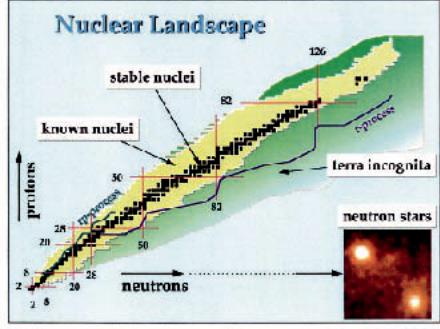
Nuclear Physics: The Core of Matter, The Fuel of Stars
http://www.nap.edu/catalog/6288.html
50 |
NUCLEAR PHYSICS: THE CORE OF MATTER, THE FUEL OF STARS |
FIGURE 3.1 The bound nuclear systems are shown as a function of the proton number Z (vertical axis) and the neutron number N (horizontal axis). The black squares represent the nuclei that are stable, in the sense that they have survived long enough since their formation in stars to appear on Earth; these form the “valley of stability.” The yellow color indicates man-made nuclei that have been produced in laboratories and live a shorter time. By adding either protons or neutrons, one moves away from the valley of stability, finally reaching the drip lines where nuclear binding ends because the forces between neutrons and protons are no longer strong enough to hold these particles together. Many exotic nuclei with very small or very large N/Z ratios are yet to be made and explored; they are indicated by the green color. The proton drip line is established by experiments up to Z = 83. In contrast, the neutron drip line is considerably further from the valley of stability and harder to approach. Except for the lightest nuclei where it has been reached, the position of the neutron drip line is estimated on the basis of nuclear models; it is uncertain due to the large extrapolations involved. Green and purple lines indicate the paths along which nuclei are believed to form in stars; only some of the dominant processes are shown. While these processes often pass near the drip lines, the nuclei decay rapidly within the star into more stable ones. One important exception to this stability plot occurs in extremely massive and compact aggregations of neutrons, neutron stars, under the combined influences of the nuclear forces and gravity.
Copyright © National Academy of Sciences. All rights reserved.
Nuclear Physics: The Core of Matter, The Fuel of Stars
http://www.nap.edu/catalog/6288.html
THE STRUCTURE OF NUCLEI |
51 |
Unique information on the strong force between hadrons can be obtained by comparing the forces between two nucleons and between a nucleon and a lambda particle in which one of the quarks is a heavier strange quark. Any difference between these forces is entirely due to the change in a single quark. The force between the lambda particle and the nucleon is being mapped with the improved experimental capabilities at CEBAF, as well as through the investigation of bound nuclear systems called hypernuclei, in which a nucleon is replaced by a lambda particle.
Even the best available parameterization of the nucleon-nucleon force cannot accurately explain nuclear binding. In order to reproduce the binding energies of the simplest light nuclei, it is essential to add three-body forces to the pairwise interactions determined from nucleon-nucleon scattering. Such threenucleon forces are expected because the nucleons are themselves composite objects whose constituents can be distorted by an external force. A more familiar example of such a three-body force is known from the analysis of orbits of artificial satellites. In the Earth-moon satellite system, the tides induced by the moon in oceans in turn alter Earth’s pull on the satellite. The nuclear three-body forces are believed to be rather weak, and it has not been possible yet to measure their small effects on the scattering of three nucleons. For now, the strengths of three-body forces have been adjusted to reproduce the binding energies of light nuclei. However, a satisfactory microscopic picture of the three-body force between nucleons is still lacking.
ADVANCES AND CHALLENGES IN
UNDERSTANDING LIGHT NUCLEI
An important ongoing research effort is devoted to measuring various properties of light nuclei having up to eight nucleons. These are the simplest of all nuclei, and the first quantitative comparisons between experimental and theoretical maps of their global and short-range structure have been made. These nuclei are ideal for probing the microscopic aspects of nuclear structure, especially those related to quarks and gluons. The light nuclei also have important roles in astrophysics, elementary particle physics, and energy production. For example, most of the matter in the visible universe is in the form of these light nuclei. The nuclear physics of the Big Bang and of conventional stars like our Sun is primarily governed by the reactions between light nuclei. Nuclear fusion reactors would use some of these reactions as their energy source.
Free neutrons are unstable to radioactive decay. Deuterium (2H) and helium- 3 (3He) are the best available surrogates for neutron targets, needed for comparative measurements of the internal structure of neutrons versus protons. A detailed understanding of the structure of these nuclei is necessary for interpreting the results of such experiments.
A direct way to probe the structure of nuclei is again through electron scat-
Copyright © National Academy of Sciences. All rights reserved.
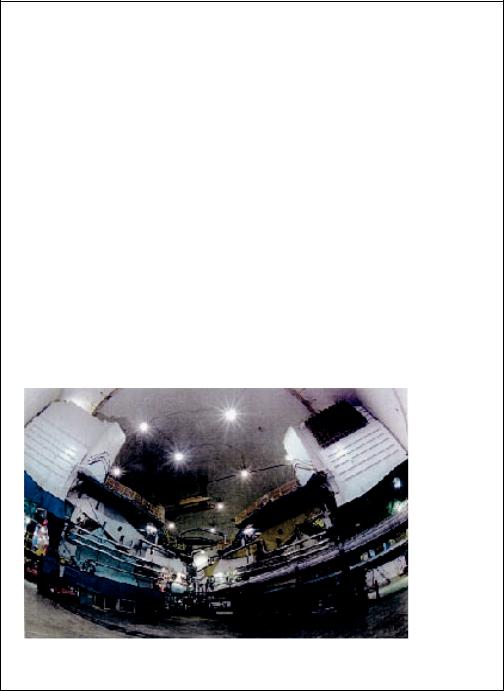
Nuclear Physics: The Core of Matter, The Fuel of Stars
http://www.nap.edu/catalog/6288.html
52 |
NUCLEAR PHYSICS: THE CORE OF MATTER, THE FUEL OF STARS |
BOX 3.1 A Microscope to Measure the Distributions of
Protons and Neutrons in the Nucleus
By bombarding nuclei with electrons from the new generation of electron accelerators and using pairs of spectrometers to detect both the scattered electron and a proton ejected from the nucleus, valuable new insight is gained into how protons and neutrons are distributed in the nucleus. The energies and angles of the electron and proton are measured with the spectrometers, and from this the energy E and the momentum k of the recoiling excited nucleus are deduced. The twodimensional energy-momentum map yields precision information on the nucleus.
As shown in Figure 3.1.1, at small values of E (the so-called valence knockout region, where the recoiling nucleus is in or near its ground state), sharp spikes appear. When E is fixed to be on one of these spikes and the distribution in momentum k is examined, the resulting pattern gives a clear picture of how the least-bound proton orbital is distributed in the nucleus, providing a powerful highenergy electron microscope for studying nuclear structure.
At high excitation energies (hundreds of MeV), the picture is much less clear.
From work at intermediate energies, it is known that there is a significant probability for such reactions to occur. The violence of these reactions breaks the recoiling nucleus into fragments; theoretical studies lead us to expect that the short-range part of the nuclear force must play a major role in the process. An important goal of experimental and theoretical studies of such (e,e´p) reactions at high energies is to explore this new territory, that is, the high-E, high-k part of the excitation map.
Studies of (e,e´2p) reactions, where an energetic electron knocks out two protons, offer an additional, promising tool for finding two protons close together inside the nucleus, an excellent measure of the short-range correlations.
Copyright © National Academy of Sciences. All rights reserved.
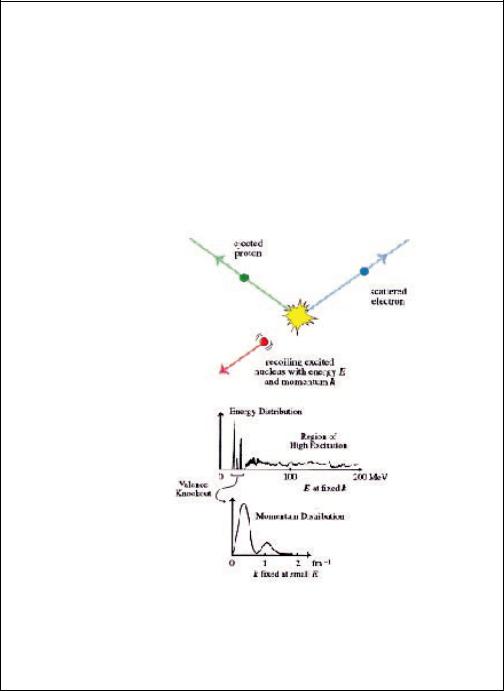
Nuclear Physics: The Core of Matter, The Fuel of Stars
http://www.nap.edu/catalog/6288.html
THE STRUCTURE OF NUCLEI |
53 |
CEBAF was constructed in part with these kinds of studies in mind. It is capable of the required precision measurements and exceeds the capabilities of previous high-intensity accelerators in this energy range by orders of magnitude.
CEBAF is now starting to open a fascinating new window for studies at short distance scales.
There are additional new knobs to turn in electron-induced studies of nuclear structure. These involve using spin to filter out special features of the reaction.
The new generation of electron accelerators all have polarized electron beams, where the spin of the electron is pointed in a direction that is controlled in the experiment. For one of the spectrometers shown in the photograph on the left in
Figure 3.1.1, it is possible to measure the direction of the ejected proton’s spin; in other cases, the nuclear target may be polarized, having its spin pointed in some specific direction. The control of these spins amounts to having selective knobs at the experimenters’ fingertips; in favorable cases, it allows the construction of threedimensional views of nuclear structure.
FIGURE 3.1.1 Experiments in which electrons knock out protons bound in the nucleus and both are detected in coincidence are being used to probe the distributions of nucleons in the nucleus. The photograph on the left shows an example of the equipment required for these experiments at high energies—the high-resolution spectrometers used in Hall A at CEBAF. On the right, results from previous studies with intermediateenergy electrons are shown. (Courtesy Thomas Jefferson National Accelerator Facility.)
Copyright © National Academy of Sciences. All rights reserved.
